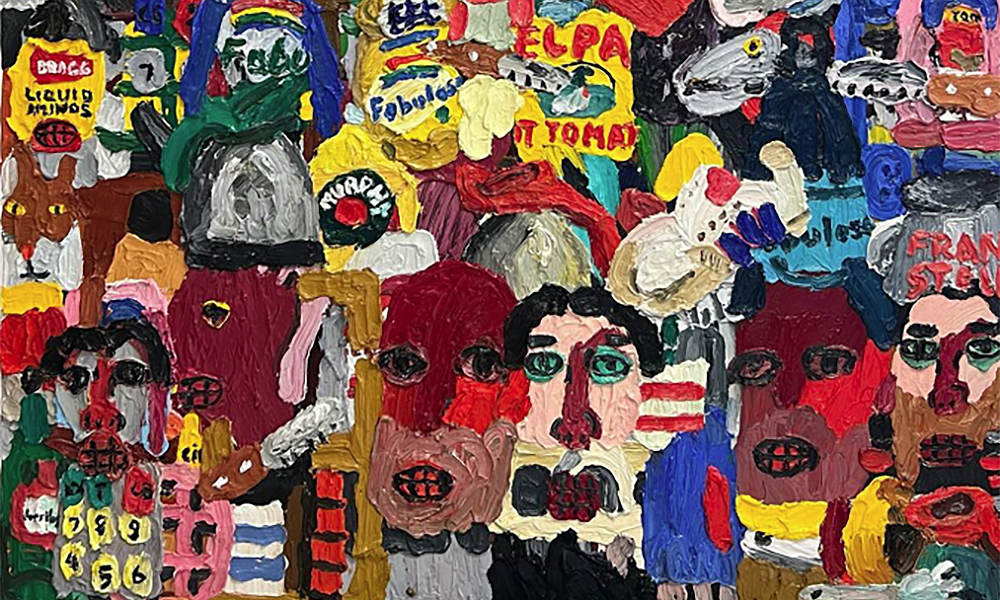Emilio Villalba: Everything is Something 2024
On view August 9 through December 8, 2024
The selection of Emilio Villalba’s paintings in this exhibition range in subject matter from the vast (“Everything”) to the specific (“Something”). Villalba presents visitors with two separate challenges — to find meaning in the mass presentation of a multitude of people and objects, or to focus solely on the individuals or objects the artist has selected for them. Depending on the individual viewer’s mindset, one viewing process may come more easily than the other.
Villalba’s large-scale, brightly colored paintings explode with the joys and chaos of everyday life. Jars of peanut butter, basketball nets, electronics, bottled condiments, and potted houseplants are interspersed with individual portraits of friends and loved ones. Bicycle wheels, beer bottles, and cans of paint — common detritus from an artist’s studio — spread from one corner of the canvas to the other, in a manner similar to Abstract Expressionist Jackson Pollock or even his predecessor, Impressionist Claude Monet. By refusing to provide the gallery visitor with a focal point, Villalba leaves the viewer with no other option but to do what is required: systematically scan the painting while the brain carefully registers what is being presented — humanity.
In these works, nothing necessarily stands out on the canvas as the “subject,” one robbing the attention of another. The descriptors “modest” and even “self-deprecating” come to mind as a way to come to terms with why these paintings resonate so strongly with the viewer and, ironically, why they are so special.
Highly personal human figures depicted within private, domestic interiors contrast with the images of everyday objects such as a tea kettle and empty soda bottles. Yet, like Wayne Thiebaud decades before him, Villalba depicts both human figure and inanimate object with such painterly force that the object appears to radiate a life energy all its own. Thick, juicy schmeers of impasto make the artist’s physical presence felt on every canvas, each inhabiting its own unique emotion.
Reclining Self-Portrait, for example, recalls the distant introspection of German Expressionist Ernst Ludwig Kirchner while Tea conjures the French Fauve Matisse. Yet another noteworthy quality of his work is the manner in which Villalba reminds us that the artist and the viewer are actually not so dissimilar after all, a notion promoted in the Renaissance but turned on its head in 1950 when the promotion of the idea of “artistic genius” emerged. Thus, Emilio Villalba’s paintings present yet another contradiction — they are at once the history of painting and at the same time the entirely unique representation of a 21st century artist’s personal life experience. The complexity and inherently contradictory nature of Emilio Villabla’s work, like all great art, is a fitting reflection of our current society.
— Allison C. Smith, Ph.D., Professor, Art History and Chair, Art History and Humanities, Johnson County Community College
Emilio Villalba (b. 1984) received a Master of Fine Arts in Painting from the Academy of Art University, San Francisco in 2012 and a Bachelor of Fine Arts in Animation from the Art Institute of California, Santa Ana in 2006.
The Nerman Museum of Contemporary Art is proud to present Villalba’s premiere solo museum exhibition.


